All about mango: what it is, what it looks like and where it grows
Mango means “great fruit” in Sanskrit. The fruits of the mango tree are so popular in some countries that in terms of consumption they exceed the amount of bananas and apples eaten in the world. A variety of salads, desserts, sauces are prepared from them, and added to soups and side dishes. Let's look at what a mango tree looks like, where and how it grows in nature, and whether the plant is suitable for growing at home.
What is mango: botanical description, what it looks like and where it grows in nature
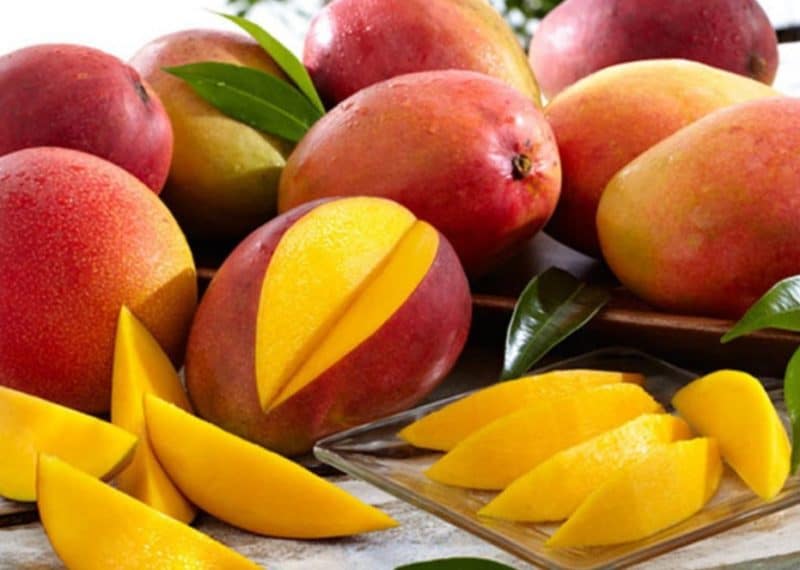
Mango is a tropical plant of the Mango genus of the Sumacaceae family, which is considered an important agricultural crop. Differs in the following botanical description and characteristics:
- An evergreen tree with a height of 10 to 45 m. The trunk is straight, the crown is dense and round in shape.
- The leaves are dense, oblong, with pronounced veins and slightly wavy edges. Length - up to 40 cm, width - up to 10 cm. The color depends on the age of the plant: young leaves have a reddish tint, mature leaves are dark green.
- The flowers are small, cream or pinkish in color. Collected in panicles, which contain up to 4000 flowers. Only 1-2 fruits ripen in an inflorescence. They have a pleasant aroma.
- The fruits are round or oblong drupes measuring 5-25 cm and weighing 250-800 g. The weight of some specimens can reach up to 2-2.5 kg. The skin is thin, smooth, yellow and reddish-yellow in color. The pulp is juicy and soft orange in color. The taste is sweet, with a slight sourness.
The mango season, when the crop is harvested and sold, is from May to August.
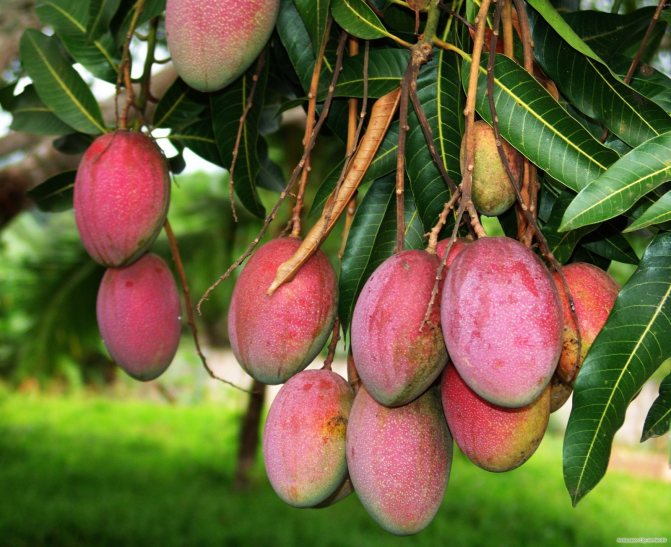
Interesting facts about mangoes
A few facts about mangoes:
- Where does mango grow? The plant originally grew in tropical rainforests on the border of the Indian state of Assam and Myanmar. Now it is cultivated in all regions of the world with a suitable climate: in Thailand, Vietnam, Cuba, etc.
- Is mango a fruit or a berry? This is a fruit.
- Is mango a citrus? No, the culture has nothing to do with citrus fruits. Botanical relatives are cashews, pistachios, Jamaican plums, and poison sumac.
- What does mango have to do with vegetables? Unripe mangoes are consumed as a vegetable, making marinades, pickles, and thick sauces.
Is it possible to grow mangoes at home and how to do it
Growing mangoes at home is not difficult. Moreover, in most cases, a seed from a fruit purchased in a store germinates successfully.
In the future, it’s just a matter of creating optimal conditions for the seedling and proper care. You shouldn’t think that the way a mango tree grows in nature, that’s how it will be at home. At home, the plant reaches no more than 1.5 m in height and, without grafting, will delight only with its decorative properties.
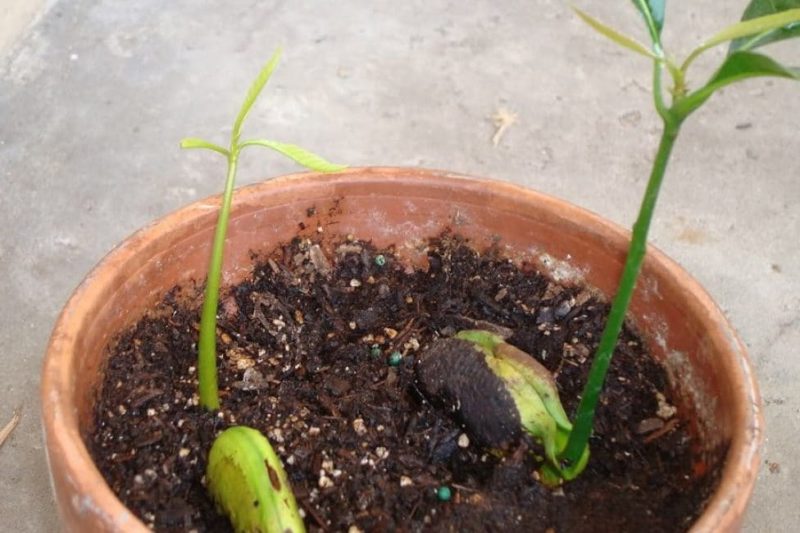
Preparing the pit
To successfully grow a plant from seed, it is important to buy a ripe mango. It is worth paying attention to fruits without signs of damage or impacts.
They should be elastic to the touch and recover quickly with light pressure. A distinctive feature of ripe fruit is a pleasant fruity smell without foreign impurities.
Reference. Ripe mango seeds have good germination rates - approximately 70%.
To prepare the seed for planting, you need to do the following:
- Peel the fruit and separate the pulp.
- Rinse the seed under running water.
- Using a knife, carefully open the seed and remove the seed.
- Place the kernel in a weak solution of potassium permanganate for 10 minutes. This treatment will prevent the development of fungal infections.
All activities should be carried out with a fresh seed. If it sits for several days, it will dry out and germination will decrease to a minimum.
How to germinate a seed
Germination in fabric is the easiest and most reliable way to achieve the appearance of a sprout. To do this you need:
- Place the seed in damp gauze, soft cloth, or towel.
- Wrap in a bag and place in a container with a lid.
- Place the container in a warm and dark place.
- Control the moisture level of the fabric by wetting the bundle daily. This is convenient to do from a spray bottle.
After about 5-14 days, a sprout will appear. The plant is now ready to be planted in the ground.
Soil for planting
Any universal primer will do, special soil for tropical plants, substrate for succulents, a mixture of peat and sand in a 2:1 ratio. All this can be found in any flower shop.
Reference. The soil should be light and loose with a neutral acidity level.
Expanded clay, small crushed stone, broken brick, and gravel are suitable as a drainage layer.
It is better to take a pot with a diameter of 9-10 cm with drainage holes. The container must be high so that the roots have room to grow, because mango is a plant with a two-tiered root system: one is located close to the surface of the soil, and the second, in the form of a rod, goes deep.
Landing
Planting a germinated seed consists of several successive steps:
- Place a drainage layer 5-6 cm thick on the bottom of the pot.
- Pour soil up to the edge of the pot.
- Make a small depression in the center of the soil and place the seed in it with the sprout facing up.
- Sprinkle with soil so that ¼ of the seed remains above the soil surface.
Cover the pot with film to create a greenhouse effect and place in a warm and bright place. Once every 3 days, open the film for 5-10 minutes to ventilate the sprout.
After the first true leaves appear, the ventilation time is gradually increased until the film is completely removed.
Watering
After planting, water the seed with filtered or settled water at room temperature. It is not necessary to moisturize abundantly. This should especially be monitored during the period after planting, when the sprout does not yet have a developed root system.
Home care
In the homeland of mangoes in the tropics it is warm, there is a lot of light, and high humidity.
For normal development, the plant needs to create and maintain conditions all year round that are as close to natural as possible: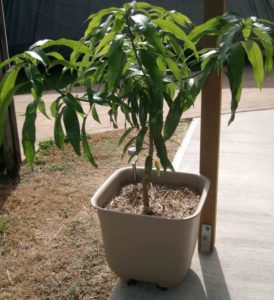
- Water regularly as the top layer of soil dries. The water should be settled and at room temperature.
- Lighting. A grown tree loves good lighting and plenty of sunlight. The plant can be safely placed on a southern windowsill. In autumn and winter it is important to provide additional lighting.
- Temperature – +26…26°С, without sharp fluctuations.
- Humidity is high. To do this, you can place a container of water near the plant, place a humidifier in the room, or spray the seedling daily with a spray bottle.
- Feeding. For better growth, apply fertilizer 2 times a month, alternating organic fertilizers with mineral ones.
- Trimming. Do the first pinching of the top after the 8th leaf. After the tree reaches 1.5 m in height, carry out formative pruning every spring: shorten all thickening branches and the central branch.
- Transfer.In the first few years, replant once a year, choosing a more spacious pot. In the future, reduce the frequency of transplants to once every 3 years.
How it blooms mango grown from seed, can be seen only 5-6 years after planting. Such a plant will not produce a harvest. Vaccination is required for fruiting.
Kidney grafting
Grafting a bud (budding) for fruiting a seedling is carried out as follows:
- Cut a growth bud from a fruiting tree along with a shield of surrounding tissue 2 mm thick and 1-2 cm in diameter. Cut with a sharp, treated knife, blade or scalpel.
- Make an X- or T-shaped cut on the bark of the rootstock seedling.
- Insert the shield of the cut growth point into the incision.
- Wrap the grafting site with polyethylene so that the bud remains outside.
- Cover the seedling with a transparent bag, making holes in it for ventilation, and place it in a bright and warm place.
After grafting, the plant will begin to bloom in 2-3 years, and bear fruit 3 months after flowering.
Disease Prevention
The plant does not have any specific diseases brought from its homeland. All you need to know about mangoes is that they are susceptible to the same diseases that affect other houseplants. Most often it is powdery mildew, bacteriosis, anthracnose.
Reference. The cause of diseases can be errors in care or proximity to already infected plants.
To prevent these diseases, you should follow some rules:
- adjust watering, normalize humidity, eliminate temperature changes in the room;
- quarantine new indoor plants;
- periodically inspect the foliage and trunk for lesions;
- treat once a month with the following preparations: “Fitosporin-M”, “Planriz” or “Alirin”.
You should not use organic-based folk remedies for prevention, as this will contribute to the development of the rotting process.
Dwarf varieties suitable for growing at home
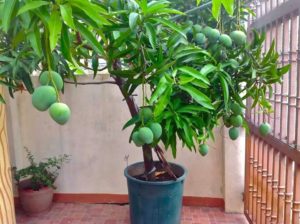
There are about 1,500 varieties of mangoes.
Of these, several dwarf and compact varieties can be distinguished, most suitable for growing at home:
- Julie - a popular dwarf variety. The height of the plant does not exceed 2-3 m. The fruit is green-yellowish with a pink side. Weight – 200-250 g. The taste is sweet and delicate.
- Malika - a compact, fast-growing tree. The fruits are medium-sized yellow with juicy sweet pulp.
- Springfels - a low, slow-growing tree. The fruits are yellow with pink spots. Weight – 150-180 g. Mango tastes like pineapple.
Dwarf varieties are adapted for growing in limited spaces and bear fruit better.
Pet Toxicity Warning
The juice of the leaves is poisonous and can be fatal to pets, so place the pot with the plant out of reach of pets.
The leaves are also toxic to humans. They can cause allergies, rashes, and redness of the skin. In this regard, all mango pruning work must be done with gloves.
When leaves and wood are burned, toxic gases are released that cause irritation to the mucous membranes of the eyes and lungs.
This is interesting:
What are the harms and benefits of mangoes for a woman’s body?
What is the calorie content of mango and what are its benefits and harms?
Conclusion
Mango is one of the most popular fruits in the world.You can grow it yourself at home from a seed, having previously found out the main points that we discussed in the article: where mango grows in nature and what climate it needs to be created, how to care for it and what precautions to take. Mangoes are most often grown for decoration, but if you want to please yourself with the fruits, you need to get grafted and put in much more effort.